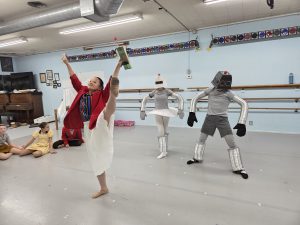On many college campuses, undergraduate fashion usually consists of whatever items of clothing are “good enough” to throw on when rolling out of bed five minutes before class starts. But on Feb. 27, SCU’s student fashion designers at the 7th Annual Eco-Fashion Show proved that a collegiate fashion sense could not only be chic but also sustainable.
The event, run by SCU’s Center for Sustainability, Retail Management Institute (RMI), and the Santa Clara Community Action Program (SCAAP), featured more than just student fashions. There were also opportunities to support sustainable retailers such as Crossroads Trading Company, which sells recycled and new clothing options and EDIT, “a modern mercantile of curated goods” based out of Washington State. Booths were also set up around the temporary runway space in the de Saisset Museum. Besides making t-shirt bracelets or picking a henna design, visitors could learn more about the sustainable clothing industry.
The evening’s student co-hosts juniors Megan Michel (Student Engagement Intern at the Center for Sustainability) and Marisa Rudolph (Program Coordinator for SCAAP’s “Bronco Leaders for Environmental Justice Investigating Truth” group) emphasized the availability of sustainable fashion choices throughout the show. “This is not just a hippie, tie-dye shirt wearin’, liberal-socialist, climate alarmist construction,” Michel said. “This is a concept that concerns all people, all around the world and is an integral part of the Santa Clara community.”
To introduce the concept of “reducing, reusing, and recycling” their clothing, Michel and Rudolph first showed three short videos to the audience. These videos highlighted the issue of today’s “fast fashion” of poorly made and rapidly-out-of-fashion products, the environmental and human health toxins still found in clothing manufacturing processes, and the poor working conditions of textile factories.
With the more solemn portion of the show complete, Michel and Rudolph introduced the faculty and student panelists who would vote on the winning runway designs. The challenge for the volunteer student designers was to reuse old materials in fashionable ways for looks that could either be worn again or recycled after the show. Each of the show’s models also carried a frequently asked question about sustainability as the answer was projected behind them.
The inspiration behind the 10 looks this year showcased a diverse campus community. From a jacket that highlighted the designer’s Indian and American background to a look inspired by the recent Women’s March to another student’s focus on rising sea levels, each runway walk had something to say. Many featured materials–from paper bags to water bottles to old tablecloths–wowed the crowd with their creative re-interpretations. With such a wealth of fashion to choose from, the judges ended up selecting winners in three categories: “Best Use of Recyclable/Waste Materials,” “Who Wore It Best,” and “Most Likely to be Worn in Real Life.”
Alma Orozco, the runner-up in the “Best Use of Recyclable/Waste Materials” category for her design “#rebottled,” was simply happy to have participated. “I’ve always wanted to be part of the show,” the senior psychology and child studies double major said. “It was on my SCU bucket list.”
For the show organizer and Center for Sustainability Coordinator Cara Uy, engaging new participants like Orozco is one of the great outcomes each year for the Eco-Fashion Show: “I think this event challenges students in different ways. It’s a chance to learn about tangible actions they can do everyday but we are also encouraging students to be creative and innovative. After all, we’re showing that anyone can be sustainable.”













0 comments